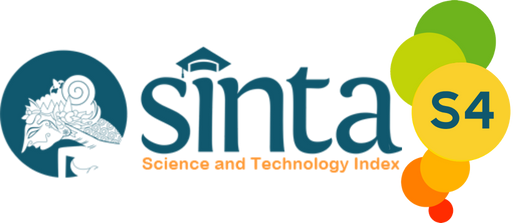SIKAP MASYARAKAT SEKITAR KAWASAN MARUNDA TERHADAP RESTORASI EKOLOGI HUTAN MANGROVE DI KELURAHAN MARUNDA, KECAMATAN CILINCING, JAKARTA UTARA
Abstract
This research aims to determine the factors that shape the attitudes of the community, to know the attitude of the community, to analyze the relationship between the factors that shape the public attitudes, and to analyze the differences of people's attitudes toward the economic impacts of the people who live close to the restoration site with the people who live far from Location of restoration of ecological restoration of mangrove forest. The location of the study was determined purposively. The sampling method used is proportional random sampling, with sample number 60 Marunda Pulo community. The result of the research shows that: (1) There is a significant relationship between the attitude of the community with the influence of others who are considered important. While there is a non-significant relationship between the attitude of the community towards age, type of work, formal education, non-formal education, and mass media exposure. (2) There is a significant difference between the attitude of the people whose location is 400 meters away from the coast with the attitude of the people whose residence is more than 400 meters from the beach.
Keywords
Full Text:
PDFReferences
Ach. Muhib, Zainuri, Anang Takwanto dan Amir Syarifuddin. 2017. Konservasi Ekologi Hutan Mangrove di Kecamatan Mayangan Kota Probolinggo. Malang : Universitas Muhammadiyah Malang
Ahmadi. 1999. Psikologi Sosial. Melton Putra. Cetakan -1. Edisi Revisi. Jakarta.
Azwar, Saifuddin. (2005). Sikap Manusia: Teori dan Pengukurannya. Yogyakarta: Pustaka Pelajar.
Dahuri, R. 1991. Dinamic Interaction between Regional Development and Kutai National Park, East Kalimantan, Indonesia. Journal. Bogor : Bogor Agricultural University.
Effendi, S dan Tukiran. 2014. Metode Penelitian Survei. Jakarta: LP3ES.
Hurlock, E. B. 1999. Psikologi Perkembangan : Suatu Pendekatan Sepanjang Rentang Kehidupan (terjemahan Istiwidayanti &Soedjarwo), Edisi 5. Jakarta : Penerbit Erlangga. JG Kairo, F Dahdouh-Guebasm, dan N
Koedam. 2001. Restoration and management of mangrove systems - a lesson for and from the East African region. Laboratory of General Botany and Nature Management, Mangrove Management Group. JournalBotany 67 : 383- 389. Nazir, Moh. 2005. Metode Penelitian. Jakarta: Ghalia Indonesia
Notoatmodjo, Soekidjo. 2003. Pengembangan Sumber Daya Manusia. Jakarta : PT Rineka Cipta.
Nursalam. 2008. Konservasi Sumberdaya Ikan di Indonesia. Jakarta. Direktorat Konservasi dan Taman Nasional Laut, Direktorat Jenderal Kelautan, Pesisir dan Pulau-pulau Kecil, Departemen Kelautan dan Perikanan. 66 hal.
Peter Saenger. 1996. Mangrove restoration in Australia: a case study ofBrisbane International Airport. Australia : Southern Cross University.
Setyawan, AD dan Winarno, K. 2005. Permasalahan Konservasi Ekosistem Mangrove di Pesisir Kabupaten Rembang Jawa Tengah. Jurnal Biodiversitas. (2) : 159-163.
Siegel, Sidney. 1997. Statistik Non Parametrik. Jakarta : Bumi Aksara.
Singarimbun, Masri dan Sofian Effendi. 1995. Metode Penelitian Survei. Jakarta: Media Pratama.
Tarsoen Waryono. 2008. Restorasi Ekologi Hutan Mangrove ( Studi Kasus DKI Jakarta ).
Yuni Tri, Hewindati et al. 2013. Manfaat Pengelolaan Hutan Mangrove Suaka Margasatwa Muara Angke terhadap Aspek Ekologis Kesehatan dan Ekonomi Masyarakat. Depok : Departemen Kesehatan Lingkungan Fakultas Kesehatan Masyarakat Universitas Indonesia.
Refbacks
- There are currently no refbacks.






